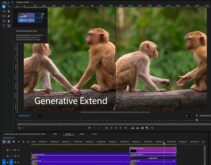 In stark contrast to earlier generations of AVCHD camcorders, by design and feature set, the AG-HMC150 is the first camcorder targeted squarely at the professional market. This is the first AVCHD camcorder that I’ve tested that looks, feels, and works like a truly professional camcorder. During the camcorder’s month-long stay, I filmed an informal concert at a local dinner theater and several events around town, including a meet-and-greet for America’s Got Talent finalist and local celebrity Alexandra Pyles.
In stark contrast to earlier generations of AVCHD camcorders, by design and feature set, the AG-HMC150 is the first camcorder targeted squarely at the professional market. This is the first AVCHD camcorder that I’ve tested that looks, feels, and works like a truly professional camcorder. During the camcorder’s month-long stay, I filmed an informal concert at a local dinner theater and several events around town, including a meet-and-greet for America’s Got Talent finalist and local celebrity Alexandra Pyles.
At the dinner theater, which I shot under relatively low light, I matched the HMC150 against the Sony HDR-FX1, an older HDV-based camcorder that performs well in low-light conditions. As night fell and ambient light decreased, both images got noisy, but the HMC150 held its own. This is significant, because one of the major concerns about AVCHD camcorders is their noise levels. Otherwise, video shot under good lighting was relatively noise-free, and colors were strong and vibrant — significantly improved from those of previous AVCHD camcorders I’ve worked with.
The HMC150 uses the same basic form factor as the AG-HVX200 and more recent AG-HPX170 (see my review at digitalcontentproducer.com/
cameras/revfeat/panasonic_aghpx_1001), with a 3.5in., 210,000-pixel color LCD panel on the left; a 0.44in., 235,000-pixel color viewfinder in the back; and most controls on the left-hand side. There is no tape drive, and the single SD/SDHC slot sits directly beneath the viewfinder, much like the P2 cards on Panasonic’s DVCPRO HD line. Panasonic claims that using solid-state storage contributes to the unit’s reliability, and the company backs the claim with a generous three-year warranty.
The AG-HMC150 has three 1/3in. CCDs. It shoots in 1080/60i, 1080/30p, 1080/24p, 720/60p, 720/30p, and 720/24p — all in AVCHD format — at a maximum data rate of 24Mbps. At that highest quality level, a 16GB SD card holds 90 minutes of video. The price for 16GB is now about $100 and dropping quickly, so this camera can serve a wide variety of markets — including ENG, corporate, and event video.
The camcorder features a Leica Dicomar lens with optical image stabilization, a 13X zoom, and f/1.6-f/3.0 (f=3.9mm to 51mm; 35mm equivalent: 28mm to 368mm). There are two control rings: one for zoom and one that you can configure for either iris or focus. There are separate controls for gain, shutter speed, and aperture. When shooting in sunlight, you’ll appreciate the neutral-density filters with settings at 1/4, 1/16, and 1/64.
I/O is extensive. For audio, the unit features two XLR connectors with +48V phantom power and a headphone jack for monitoring. Video outputs include HDMI, component, and composite, coupled with stereo audio via RCA jacks. You can transfer video by USB or by copying the SD-card memory directly via a compatible reader on your computer. There is no FireWire port on the camcorder.
You use a joystick mechanism for working through your menu options and playing back your clips, which works well. Overall, the menu presents the camera’s options in plain English, making the HMC150 very easy to use, even for most beginners.
New features
The HMC150 debuts a number of features previously unseen in this price range or category — including a waveform monitor, expanded focus assist, Dynamic Range Stretch (DRS), and a prerecord cache, which continuously stores 3 seconds of video before you press the record button.
The other features deserve a bit more explanation, and I’ll start with the waveform monitor. As you probably know, a waveform monitor displays the brightness of pixels in the frame along the IRE scale, with 100 IRE pure white and 0 IRE pure black. Values are displayed along the horizontal positioning within the frame, so you can easily assign brightness values to various elements in the frame — such as a white-balance card, which should be at or near 100 IRE, or a Caucasian face, which should be between 70 IRE and 80 IRE.
A waveform monitor adds a valuable degree of exposure-related granularity that you can’t easily get from zebra stripes. If you’ve ever shot with one, you really hate to do without. However, due to the cost of a standalone waveform monitor, relatively few shooters outside of the film or broadcast worlds use them. Serious Magic’s groundbreaking DV Rack software (now Adobe OnLocation) brought the cost way down, but you still need a computer around to run the program.
Panasonic makes this feature easily accessible by including a waveform in the HMC150’s LCD panel. You access it via the Scopes button that loops you through the normal preview, waveform display, a vectorscope (which I find less useful, so I won’t describe it), and then back to normal preview. Neither scope appears in the viewfinder, so you can focus and frame in the viewfinder, then check exposure on the LCD. You can view either monitor while actually recording, which is great for working under changing light conditions (see Figure 1).
With the HMC150, Panasonic is signaling that professional AVCHD is here, and here to stay. As with the HPX170, the new focus- and exposure-related features put it ahead of other camcorders in its price range, and they set a bar that other camcorders will have a hard time clearing in the short term.
Figure 1. The HMC150’s Scopes button loops you through the normal preview, waveform display (pictured), a vectorscope, and then back to normal preview.You also get two levels of zebra stripes as an adjunct to the waveform. In certain shooting modes, the camera displays the luminance value of the center pixel in the frame. This should be close to or at 99+ (the maximum) when white-balancing, or you probably have an exposure problem. It’s a comprehensive, useful feature set that will help improve exposure on all of your shoots.
If you frequently shoot HD video using manual focus, you’ll also find the HMC150’s multiple focus assists hard to live without. Click the Focus Assist button, and Panasonic displays a zoomed frame in the LCD and viewfinder, accompanied by a histogram that shifts to the right as the image comes into sharp focus, which is more useful than the zoom-only focus assist offered by most other camcorders (see Figure 2). Even better, the focus assist stays visible while you’re recording; with most older camcorders, normal display returns as soon as you hit the record button, which makes little sense.

Figure 2. The HMC150’s Focus Assist button displays a zoomed frame in the LCD and viewfinder, accompanied by a histogram that shifts to the right as the image comes into sharp focus.
Though there is also a peaking display, note that the HMC150 doesn’t include all the focus aids that are included with the HPX170. Specifically, the focus bar (another visual gauge of focus levels) and Manual Focus Assist (which performs final fine-tuning adjustments) are not included with the HMC150.
Finally, DRS dynamically adjusts the gamma curve and knee slope of each pixel in realtime — which, in theory, should help preserve detail in scenes with lots of dynamic range or significant extremes in bright and dark regions. I tested this feature on the DSC Labs ChromaDuMonde test chart, which shows 11 gradations from black to white. As you can see on the upper left-hand side of both charts in Figure 3, at the maximum setting, DRS does preserve more detail in the whites. Look at the three distinct bands, which pretty much appear as an indistinguishable lump without DRS. It feels like you should have to pay a price for this expanded range, but in my limited tests, I couldn’t see any downside.
 Figure 3. With Dynamic Range Stretch on, you see more detail in the extreme whites.
Figure 3. With Dynamic Range Stretch on, you see more detail in the extreme whites.
While working with the ChromaDuMonde, I also assessed the resolution preserved by the camcorder. By way of background, Panasonic no longer releases the pixel counts of CCDs used in its camcorders, but it has stated that there are fewer pixels in the CCD than in the ultimate storage target. To make up the difference, Panasonic uses the same pixel-shifting (or more technically, biaxial spatial offset) that’s implemented in the HVX200 and HPX170. Not surprisingly, in my tests, the resolution was about the same as that of the HPX170, which is pretty lofty for a camcorder that costs several thousand dollars less.

Figure 4. America’s Got Talent finalist and local celebrity Alexandra Pyles in a frame pulled from the AVCHD file, which imported without problem into Apple Final Cut Pro and Adobe Premiere Pro CS4.
During all my shoots with the camcorder, I was continually reminded of the fact that I was storing relatively low-bit-rate video (compared to DVPRO HD, anyway) to an inexpensive — yet reasonably capacious — storage device. For example, the informal concert totaled 50 minutes of video, and I still had 40 minutes left of space on my 16GB card. That was sweet.
Back in the office, working with AVCHD was also sweet. All videos imported smoothly into Adobe Premiere Pro CS4, which I was glad to see. I could copy the video from the SD/SDHC card using a card reader on my computer, which was faster than USB (and much faster than realtime capture from tape). Apple Final Cut Pro seemed to work best when importing directly from the camcorder via the cable, which took longer, but the video edited fine in both programs. On my loaner eight-core workstations, a Mac Pro and an HP xw6600, editing with both editors felt snappy — though I didn’t run any comparative benchmarks with HDV.
With the HMC150, Panasonic is signaling that professional AVCHD is here, and here to stay. As with the HPX170, the new focus- and exposure-related features put it ahead of other camcorders in its price range, and they set a bar that other camcorders will have a hard time clearing in the short term.
 Streaming Learning Center Where Streaming Professionals Learn to Excel
Streaming Learning Center Where Streaming Professionals Learn to Excel








